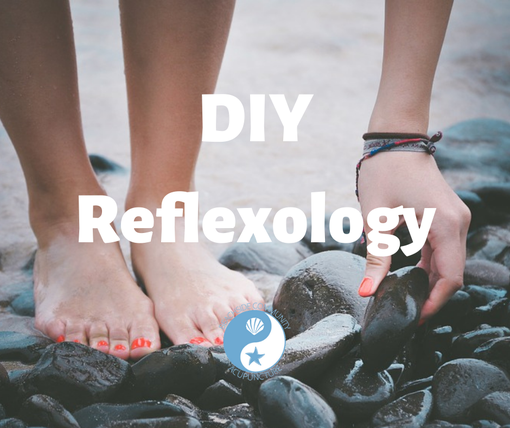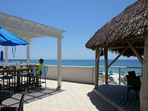
This post contains affiliate links, meaning Beachside Community Acupuncture PLLC may receive a small commission for purchases made through certain links at no additional cost to you. (In other words, you support us in a small way when you buy the products that we highly recommend and would use ourselves!) Click here to view our full disclosure policy.
If you've been to our clinic before - or have read our acupressure post - you know that we often use other parts of the body to treat areas of injury or concern. We can do this because meridians run throughout the body and connect with each other, but there are also microcosms (smaller parts that represent the whole) that can be used in a similar way. The ears, the hands, and the feet are a few examples of this phenomenon, and here we're going to focus on foot reflexology.
The Need For Foot Reflexology
Our ancestors practiced reflexology without having to think about it: Walking barefoot meant that they not only reaped the benefits of earthing, but they also stimulated various points in their feet as they traversed uneven terrain. Nowadays, our feet only meet flat surfaces, such as floor, carpet, pavement, and shoes. While this is an improvement in terms of safety, it also means that we're missing out on an easy way to promote overall wellness. Some benefits of reflexology include pain management, stress reduction, increased circulation, and relief from other conditions.
If you have a specific health concern, consulting and seeking treatment from a reflexologist is recommended. A reflexologist knows where and how to massage the feet to specifically influence the organs or other body structures that need help, and may even use the sore spots that they find on your feet to diagnose root issues. However, if you're just looking for simple ways to add reflexology to your day-to-day routine, the following ideas are for you!
Self-Reflexology
If you're aware of body parts that need a bit more support - say an aching back or weak lungs - then try a targeted approach to reflexology: Search Google Images for "reflexology charts" and massage the corresponding areas in your feet. You can use your hands, have someone else massage them for you, or apply pressure with reflexology tools. You'll probably find that the parts of your feet that represent your issue areas are more tender, so be gentle with yourself!
You can also stimulate these spots by applying essential oils to them, and if you research this more deeply, you'll probably come across the term "Vitaflex" instead of reflexology. Vitaflex points are very similar to reflexology points - many overlap - and you can experiment with following either foot map.

Passive Reflexology
If you want an overall wellness boost, exposing your feet to uneven surfaces will invariably stimulate all of the reflexology points (and therefore affect all of your organs and body structures). Walking barefoot outside, especially over gravelly or rocky patches, will do this, but be careful! Tread slowly and watch out for sharp rocks, keeping in mind that this method is not for you if your balance is unstable.
If you don't have terrain like this near you, you can "build" your own by making a rock path in your garden. Simply dig up a shallow bit of space in your yard, buy varying sizes of large rocks, arrange them so that their heights are not in line with one another, and fill in the gaps between them with dirt. By doing this, you can avoid the pitfall of coming across sharp rocks, but still be mindful of ants and other insects. Also, positioning your rock path next to a wall or fence can be helpful for balance.
Of course, there are also plenty of products that allow you to practice reflexology inside your home, everything from mats to rollers. These products make it easy to activate and/or roll out your feet, but you can also use a plain lacrosse ball or even a frozen water bottle. Just sit or stand with one of your feet on the ball or bottle, slowly lean forward to place more weight on it, and then move your foot around so that you feel pressure on different points through your sole. As always, do this next to a counter, sturdy chair. or wall if you have any issues with balance.
You can also make an indoor version of the rock path we described above by buying a silicon tray and varying sizes of pebbles. The pebbles can be dumped in the tray and remain loose for easy cleaning, or may be glued down if you find an arrangement that you really enjoy.
Putting Reflexology Into Practice
Just like with any other holistic therapy, everyone will react differently to reflexology. You may not feel any sore spots in your feet, or it may seem like your entire foot needs attention! Start slowly and be mindful of how you feel as you incorporate these strategies into your routine, being sure to remember that changes may take time. No matter what you experience systemically, you'll probably notice that your feet feel looser and happier and that you really enjoy giving them the extra TLC.

Kathleen Ketola is a Licensed Acupuncturist and the owner of Beachside Community Acupuncture. She loves providing affordable acupuncture to the residents of McKinney, Texas, and surrounding cities like Prosper, Frisco, and Plano, but she also enjoys educating the general public on how acupuncture and Traditional Chinese Medicine (TCM) can treat everything from pain to infertility to stress and beyond. Click "Book Now" at the top of this page to book an appointment or feel free to contact her at (214) 417-2260.








